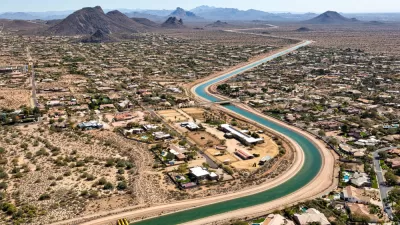The ancient irrigation networks lying below Phoenix could offer a solution to the sprawling desert city's water problems.
In this excerpt from his book "Elixir: A History of Water and Humankind", Brian Fagan explores how what is now Phoenix thrived off of the irrigation canals of the Hohokam people more than 500 years ago.
"Phoenix and its surrounding communities have paved over much of the Hohokam world. But the long-vanished farmers reappear with persistent frequency, under the foundations of modern buildings razed for new development, in the pathways of expanding interstates, even in backyard gardens. For the most part, the traces of their presence are inconspicuous, requiring careful dissection with spade and trowel. Only a few notable adobe structures still stand above ground, making it hard to believe that the Salt River Valley was the most populous and agriculturally productive valley in the Southwest before A.D. 1500. The land looks barren and utterly dry, yet it has fertile soils and lies near major river drainages. Between A.D. 450 and 1500, the Hohokam living near the Salt River adapted brilliantly to this seemingly desolate environment, refining their agriculture and water management from one generation to the next. Over more than 10 centuries, they built vast canal networks up to 22 miles long and irrigated tracts of arid land up to 70,000 acres in size."
FULL STORY: Insider: Phoenix's Looming Water Crisis

Planetizen Federal Action Tracker
A weekly monitor of how Trump’s orders and actions are impacting planners and planning in America.

Maui's Vacation Rental Debate Turns Ugly
Verbal attacks, misinformation campaigns and fistfights plague a high-stakes debate to convert thousands of vacation rentals into long-term housing.

San Francisco Suspends Traffic Calming Amidst Record Deaths
Citing “a challenging fiscal landscape,” the city will cease the program on the heels of 42 traffic deaths, including 24 pedestrians.

Amtrak Rolls Out New Orleans to Alabama “Mardi Gras” Train
The new service will operate morning and evening departures between Mobile and New Orleans.

The Subversive Car-Free Guide to Trump's Great American Road Trip
Car-free ways to access Chicagoland’s best tourist attractions.

San Antonio and Austin are Fusing Into one Massive Megaregion
The region spanning the two central Texas cities is growing fast, posing challenges for local infrastructure and water supplies.
Urban Design for Planners 1: Software Tools
This six-course series explores essential urban design concepts using open source software and equips planners with the tools they need to participate fully in the urban design process.
Planning for Universal Design
Learn the tools for implementing Universal Design in planning regulations.
Heyer Gruel & Associates PA
JM Goldson LLC
Custer County Colorado
City of Camden Redevelopment Agency
City of Astoria
Transportation Research & Education Center (TREC) at Portland State University
Jefferson Parish Government
Camden Redevelopment Agency
City of Claremont





























